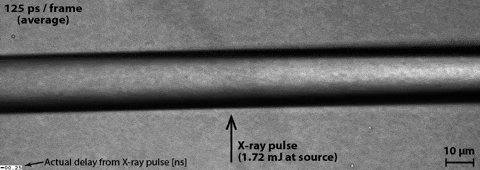Researchers in the United States have produced the loudest sound possible — for science. The team blasted jets of water with a powerful X-ray laser to generate a pressure wave slightly above 270 decibels.

What makes one sound seem louder than another is the amount of energy pushing from a source towards the listener. This energy is carried in the form of pressure variations through the air. And like any form of energy, we can measure this pressure wave in order to objectively determine loudness.
Sound level meters measure sound intensity in units called decibels (dB), a scale first devised by Alexander Graham Bell. This is a logarithmic scale, meaning it goes up in powers of ten. So every increase of 10dB is equivalent to a 10-fold increase in sound intensity. This also means that a 100db sound is about a billion times more intense than a 10dB sound and not 10 times more intense, which would be the case for a linear scale.
Sound intensity, however, does not correspond to loudness. The reason the dB scale is logarithmic is that this is how our ears work. Every 10dB increase in sound intensity is equivalent to a doubling in loudness (our perception of sound intensity). So although 100dB is a billion times more intense than a 10dB sound, it is only 512 times louder.
To get a sense of the dB scale, 10dB is as loud as nearby falling leaves, 40dB is a quiet conversation, 100dB is an operational jackhammer at close range, 110db is a jet engine taking off at 100 meters, and 140dB is a rooster crowing right next to you (yup, they’re that loud!). The loudest animal, however, is the blue whale, which can make sounds reaching almost 190 decibels.
But not even a blue whale can match the loudness generated by a recent experiment performed by Gabriel Blaj, a staff scientist at SLAC and Stanford University, and Claudiu Stan, at Rutgers University Newark. The researchers used the SLAC’s Linac Coherent Light Source (LCLS) X-ray laser to zap micro-jets of water only 14 to 30 micrometers in diameter. The short pulses were so intense that they vaporized the water, generating a shockwave that traveled through the jet in alternating high and low-pressure zones.
There’s a limit to how loud a sound can get. For air, that limit is 194dB — anything louder than that and the air starts to break down from all of the energy. Underwater, however, things can get as loud as 270dB before water molecules are destroyed.
“The amplitudes and intensities were limited by the wave destroying its own propagation medium though cavitation, and therefore these ultrasonic waves in jets are one of the most intense propagating sounds that can be generated in liquid water. The pressure of the initial shock decayed exponentially, more rapidly in thinner jets, and the decay length was proportional to the jet diameter within the accuracy of measurements,” the authors wrote in the journal Physical Review Fluids.
Besides breaking a world record, the new study also has some practical value. In the future, the findings could help scientists devise methods in order to protect miniature samples undergoing atomic-scale analysis inside water jets.



